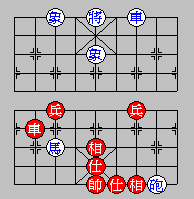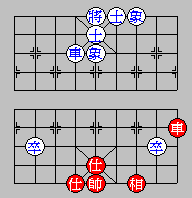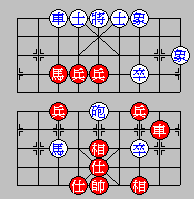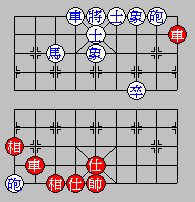32. One piece perpetually chases two pieces or more should be
ruled as a draw. Two pieces take turns to perpetually chase
two or more pieces also should be ruled a a draw. (See examples
from Diagram 76 to 80)

Diagram 76: Red (in Capital) moves first
R87 k3+2
R78 k2-3
R82 c89
R27 k3+2
R78 k2-3
R81 ....
.
.
 Diagram 77: Red (in Capital) moves first
Diagram 77: Red (in Capital) moves first
R12 p87
R23 p78
R38 p23
R87 p32
R82 ....
.
.
 Diagram 78: Red (in Capital) moves first
Diagram 78: Red (in Capital) moves first
R27 k3+1
R75 c56
R54 c65
R43 p78
R39 k1-3
R97 k3+1
R75 ....
Explanation:
In Diagrams 76, 77, and 78, the Red Rook perpetually chases two or
more pieces. Neither side violates the rule and the game can be
ruled as a draw.
 Diagram 79: Red (in Capital) moves first
Diagram 79: Red (in Capital) moves first
C7+1 r4-2
C7-2 r4+1
C7+2 r4-2
C7-2 r4+2
C7+2 ....
Explanation:
The Red Cannon's perpetually chasing the two Black Pawns does not
violate the rule but the Black Rook's perpetually chasing the Red
Cannon does. Black has to change or lose.
 Diagram 80: Red (in Capital) moves first
Diagram 80: Red (in Capital) moves first
R12 c89
R89 c12
R21 c98
R98 c21
....
Explanation:
The two Red Rooks' perpetually chasing the two Black Cannons does
not violate the rule. If neither side wants to change the move,
this game should be ruled as a draw.





